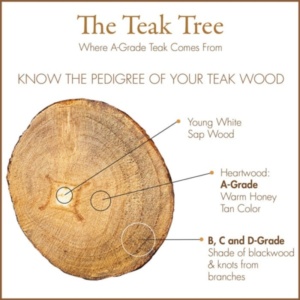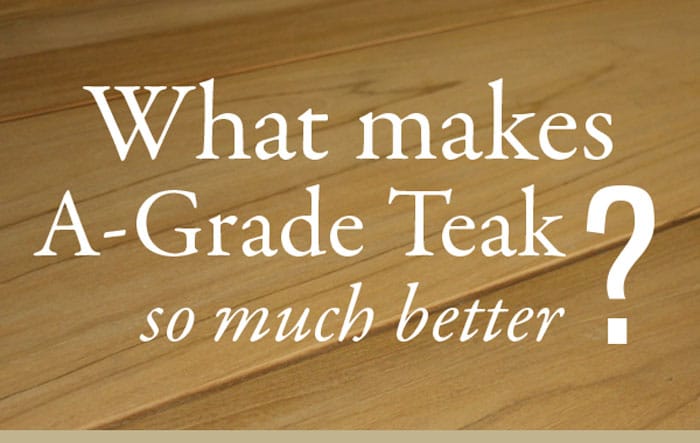Grade-A teak features a grain that is tight and even, the color is consistent and warm with golden wheat and honey tones, and the naturally occurring compounds of the wood make it highly resistant to common outdoor element issues such as insect and moisture problems. A-Grade Teak is the premium center cut of the teak timber and makes up about 30-40% of the timber. It is cut from mature teak trees, and unlike lesser quality teak wood, Grade-A teak offers a consistent look without knots, discolorations, or other unwanted variations.
Due to the natural compounds that exist in this hardwood, teak wood offers incredible benefits over other natural materials for use in outdoor furniture. Natural oils and rubbers help to protect this hardwood from pest damage, moisture retention, and UV damage, and help it to continue to look good for many seasons.
Unlike lesser grades of teak or other hardwoods or softwoods, A-grade teak maintains its integrity as it weathers gracefully while resisting degradation. The natural tendency for A-Grade teak is to patina beautifully into a silvery-grey look, which develops over time in natural conditions including sunlight and ambient moisture. A-Grade teak (also called Grade-A; super Grade A or triple Grade-A) is a perfect natural material for luxury outdoor furniture because it offers the finest protection and incredible good looks.
Three grades of teak wood, what’s the difference between A-Grade, B-Grade and C-Grade Teak?
Teak is known for its quality, but there are some key differences between the grades of teak wood. Hardwood teak is graded based on strict quality criteria. Teak timbers are judged by appearance, by which part of the tree the wood is cut from, and by the age of tree.
Let’s start with the lesser C and D-Grade teak, also known as sapwood. These are especially low grades of wood that are not suitable for legitimate outdoor furniture usage. Usually only used to make small trinkets in the villages near the forests where the tree was harvested, this low grade teak has variances that are drastic; in color, figure, density and stability. Often this grade of teak wood is darker, such that it resembles an almost reddish or deep brown color and has inclusions that are undesirable both in integrity and from a visual perspective.
B-Grade teak is noticeably less consistent and dense than A-Grade teak. It is a lower quality teak, with characteristically higher volume of color variation, inclusion of variances like knots and grain twisting, and a less dense grain. You may often find color differences moving from occasional tan splashes, and large darker patches, coming together with large grey and black veins between them. B-Grade teak appears to mimic the same type of wild variation as other woods like olive wood. The pattern is not consistent, and the overall capabilities of the wood for use in outdoor furniture, from a performance perspective are obviously lessened. Often ashy and powdery residues can form on B-Grade teak, creating an awkward finish; these residues might be grey, white or black. B-Grade teak often has fillers, to compensate for knots that have fallen out or for inconsistencies in the wood grain. Fillers are obvious when the wood is examined up close. B and C grade woods come from the outer core of the tree where the wood is white and sappy or they are near the outer bark of the tree trunk where there will be darker markings and more open grained wood.
The highest in quality, A-Grade teak is incredibly uniform in color, finish and hardness. There’s a very tiny allowance for knots or discoloration. More often than not with true A-Grade teak wood, such variations in wood grain don’t occur. A-Grade teak will have a naturally oily feel to it, and have a warm glow and an even color palette consisting of honey, wheat, gold, and amber. To further explain the lack of discoloration and knots in premium center cut A-Grade teak: Knots are remnants of branches. In old growth teak, the branches are much further away from the heartwood. Therefore: where a knot would have existed, there might only be a slight, linear, grain pattern variation and a line denoting the variation. There will not be the typical round knot in such center wood. In younger trees, these may manifest as true knots with a round shape, because there has not been enough development in the wood or enough heartwood to avoid knots and variations. True A-Grade teak is cut from only from mature trees.
The portion of the tectona grandis tree that A-grade teak is cut from is the very center or heartwood. It represents the most difficult teak wood to source and is also, by far the most expensive. It can represent up to about 40% of the diameter of the tree, depending on the age of the tree; the younger the tree, the less A-grade teak that can be harvested. All trees grown in Indonesia are milled at around 40 years old. This allows for stable growth perfect for manufacturing outdoor furniture. It is very well-known in the timber industry – any trees that are significantly younger will be less stable. Additionally: country of origin of the teak wood is a pertinent question to ask your wood merchant or reseller.
Since reclaimed teak by definition is not a new manufacture A-Grade teak, cannot be classified as A-Grade, though that does not necessarily mean that the original selection was not from A-Grade stock. The popularity of recycled or reclaimed teak has grown in recent years.
Machine milled vs hand-made teak outdoor furniture.
 At times there is the opinion expressed that handmade products are of higher quality than machine made products. In the Outdoor furniture market, this is NOT the case. While we can all appreciate a very high end, custom piece of furniture, those that offer such craftsmanship cannot offer consistency throughout many product lines and products. In addition, these one of a kind custom pieces are often many thousands of dollars as well.
At times there is the opinion expressed that handmade products are of higher quality than machine made products. In the Outdoor furniture market, this is NOT the case. While we can all appreciate a very high end, custom piece of furniture, those that offer such craftsmanship cannot offer consistency throughout many product lines and products. In addition, these one of a kind custom pieces are often many thousands of dollars as well.
Using computer controlled tooling and machine milling is essential to creating the tight construction quality and accurate dimensions that make for long-lasting and beautiful pieces of outdoor furniture. For those who are familiar with teak wood products, you might also be aware that there’s a trend for anything not machine-crafted, to be made from lower quality teak.
These types of lower quality pieces aren’t built to be used in varying conditions and certainly are not up to par in the quality of our manufacturing and standards of teak furniture made the way we have produced thousands of pieces of premium outdoor furniture over many years. We use machinery to produce accurate cuts, angles, joinery and planed surfaces of our A-Grade teak. When we have produced a perfect product, we then pass that along to our master craftsmen to build and finish the product into the stunning piece of furniture you see when you buy our outdoor furniture. It is this hand crafting that shows the quality of a true master craftsperson. Otherwise, generally speaking: “handmade” teak furniture is usually not quality.
Why does kiln drying matter with Teak?
Kiln drying is used to remove excess moisture to ensure that dimensions and weight, uniformity and consistency of the timber is all within a tight range of deviation. This means you get a product with accurate dimensions; a beautiful and consistent looking product, and one which showcases the best qualities that teak has to offer.
Our oven kiln drying occurs before the final dimension/shaping production on teak timbers to ensure that any shrinkage and moisture variance issues are controlled. Additionally, it helps the wood to avoid warping and cracking.
We kiln dry our wood in kiln ovens which are measured to result in approximately an 8% moisture content. The wood is then tested for moisture content again before construction to approximately a 10 to 12% moisture content, you won’t have moisture issues with the wood and you’ll be receiving the best quality teak available. The computer controlled tooling we use on our furniture will be able to achieve the most accurate dimensions and our master craftsmen will be able to produce the finest finish.
Why is the source of the teak used important?
Only from the best plantations and sustainability practices, can you yield the best product. We use wood sourced from Javanese plantations in Indonesia, under the control of the Indonesian government called the Perum Perhutani. The Javanese teak plantations are centuries old plantation tracts, with mature, old growth teak trees being harvested for timbers. The Dutch, in the colonial environment around the 1840’s, originally planted the forests; the reforestation effort is very responsibly and thoughtfully planned out. The Indonesian Government is very strict in controlling the output of these plantations and they impose very strict requirements to be able to bid on such fine teak wood. There is no other growth/production center of teak for commercial consumption that produces a finer timber than these forests. And most importantly, the high restrictions and regulations for felling of trees is so incredibly important to our global environment. Teak is a valuable hardwood, with a lot of varied uses. Plantation standards, the history of the production and the sustainability of such practices are of the utmost importance.
Recently, other countries in suitable climates have begun to grow tectona grandis, but the quality is lacking comparatively, as the trees are milled at a younger age. The tendency outside of Indonesia, is for agencies to approve the cutting down of young trees, unsuitable for high grade timbers. This is evident in the cut rate pricing and the inferior quality of the wood. Generally speaking, manufacturers willing to produce teak outdoor furniture from lesser quality teak are likely to produce an inferior product by design as well.
Teak Wood, is there anything else like it?
If you’re looking for a natural product and are interested in the wonderful benefits showcased above, then no, you won’t be able to find a hardwood with the same benefits, the gorgeous look of teak or the longevity of premium center cut A-Grade teak. Insect and rot resistance also make A-grade teak the best choice of wood for durable furniture. It is truly in a class of its own. You can find capable Synthetic materials when it comes to outdoor performance (like weather resistance and UV resistance), but it’s not a natural product like teak wood.
You can find beautiful hardwoods that aren’t teak, but you’ll not get the low maintenance of teak wood or the longevity of A-Grade teak. Teak is a perfect wood for luxury outdoor furniture because it looks amazing and it weathers incredibly well, has durability and good looks and has an impeccable track record of performance over time.
For years teak has been the preferred material for yacht decks and furniture, commercial outdoor furniture (like park benches and landmarks) and specialty installations because there isn’t another wood that offers so many wide-ranging benefits or looks as good doing it. A-Grade teak is the highest quality version of teakwood, it represents the absolute peak of teak wood specimens.
Note: Look out for furniture merchants selling teak outdoor furniture with a finish. Always purchase teak furniture with no finish, so you can see what you’re buying.
For more information on Teak you can visit the following links or to shop for true A-Grade Teak Furniture:
SHOP FOR A-GRADE TEAK OUTDOOR FURNITURE
SHOP ALL OUTDOOR FURNITURE
GENERAL OUTDOOR FURNITURE FAQ’S


